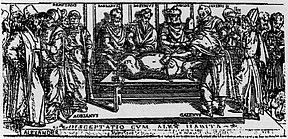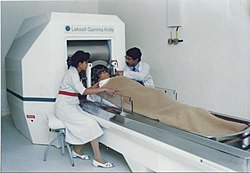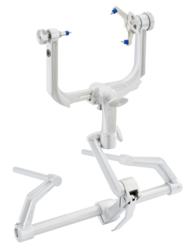History of neurology and neurosurgery
The study of neurology and neurosurgery dates back to prehistoric times, but the academic disciplines did not begin until the 16th century. From an observational science they developed a systematic way of approaching the nervous system and possible interventions in neurological disease.
Early history
Ancient
Trepanation, similar to some techniques used today, is the oldest surgical procedure known and was practised in the Stone Age in many parts of the world,[1] and in some areas may have been quite widespread. The main pieces of archaeological evidence are in the forms of cave paintings and human remains. One third of 120 skulls found at a site in France dating to 6500 BCE had undergone trepanning.[2] It was also practised widely in the pre-Columbian Andes.[3][4] These procedures were mostly performed on combatants, with evidence from skeletal remains revealing that the earliest methods usually resulted in death.[4] However, by the 1400s, Incas proved to be "skilled surgeons", as survival rates rose to about 90%, infection rates following the procedure were low and evidence was found showing that some individuals survived the surgery on multiple occasions.[4] Incan surgeons learned to avoid areas of the head that would cause injury, using a scraping method on the skull that would cause less trauma.[4] They also likely used medicinal herbs of the time, such as coca and alcohol for pain while balsam and saponin would be employed for antibiotic purposes.[4]
An

Slightly later, the
With surgery, Hua Tuo was an ancient Chinese physician and surgical pioneer who is said to have performed neurosurgical procedures.[11] In Al-Andalus from 936 to 1013 AD, Al-Zahrawi evaluated patients and performed surgical treatments of head injuries, skull fractures, spinal injuries, hydrocephalus, subdural effusions and headache.[12] Concurrently in Persia, Avicenna also presented detailed knowledge about skull fractures and their surgical treatments.[13]
Anatomy and physiology
- Along with most other sciences, the first real advances in neurology and neurosurgery after the Greeks occur in the Renaissance. The invention of the printing press allowed the publication of anatomical textbooks, pages, allowing the dissemination of knowledge. An early example is Johann Peyligk's Compendium philosophiae naturalis, published in Leipzig, Germany in 1499. This work contained 11 woodcuts, depicting the dura mater and pia mater as well as the ventricles.[14]
- A revolution took place in both neurology in particular and in anatomy in general when De humani corporis fabrica in 1543. It includes detailed images depicting the ventricles, cranial nerves, pituitary gland, meninges, structures of the eye, the vascular supply to the brain and spinal cord, and an image of the peripheral nerves.[14] Vesalius, unlike many of his contemporaries, did not subscribe to the then common belief that the ventricles were responsible for brain function, arguing that many animals have similar systems of ventricles to those of humans but no true intelligence.[15] It appears that he rarely removed the brain from the skull before cutting it, most of his diagrams showing the brain sitting inside a severed head.[16]
In 1549,
A beginning of the understanding of disease came with the first morbid anatomists, morbid anatomical illustration, and the development of effective colour printing. Matthew Baillie (1761–1823) and Jean Cruveilhier (1791–1874) illustrated the lesions of stroke in 1799 and 1829, respectively.
Bioelectricity and Microscopy
The famous philosopher René Descartes (1596–1650) speculated that every activity of an animal was a necessary reaction to some external stimulus; the connection between the stimulus and the response was made through a definite nervous path. In 1718, Isaac Newton opined in his book Opticks that the brain was sending signals to the muscles through the path of nerves.[19]
Diagnostics
The first physicians to devote entirely to neurology were
Neurosurgery
Modern
There was not much advancement in neurosurgery until late 19th early 20th century, when electrodes were placed on the brain and superficial tumors were removed.
Neurosurgery, or the premeditated incision into the head for pain relief, has been around for thousands of years, but notable advancements in neurosurgery have only come within the last hundred years.[21]
History of electrodes in the brain: In 1878
History of tumor removal: In 1879 after locating it via neurological signs alone, Scottish surgeon
Modern surgical instruments
The main advancements in neurosurgery came about as a result of highly crafted tools. Modern neurosurgical tools, or instruments, include chisels, curettes, dissectors, distractors, elevators, forceps, hooks, impactors, probes, suction tubes, power tools, and robots.[29][30] Most of these modern tools, like chisels, elevators, forceps, hooks, impactors, and probes, have been in medical practice for a relatively long time. The main difference of these tools, pre and post advancement in neurosurgery, were the precision in which they were crafted. These tools are crafted with edges that are within a millimeter of desired accuracy.[31] Other tools such as hand held power saws and robots have only recently been commonly used inside of a neurological operating room.
See also
- History of neuraxial anesthesia
- History of neuroscience
- History of neuropsychology
- History of psychology
- History of psychiatry
- History of neurophysiology
- List of neurologists and neurosurgeons
References
- OCLC 50485765.
- OCLC 43662032.
- PMID 18386793.
- ^ National Geographic. Archived from the originalon 26 February 2021.
- ^ a b Wilkins, 1964
- ^ Paulissian, 1991 p.35
- ^ Horner, I.B. "Theravāda Vinayapiṭaka Khandhaka (Mahāvagga) 8. Robes (Cīvara) The story of Jīvaka". SuttaCentral. Retrieved 7 August 2020.
- ^ World Health Organization, Fact Sheet #168
- ^ von Staden, p.157
- ^ Gross, 1998
- PMID 21452005.
- PMID 3520907.
- PMID 19437052.
- ^ a b Tessman & Suarez, 2002
- ^ Gross 1998, p. 38
- ^ Vesalius 1543, pp. 605, 606, 609
- PMID 3277602.
- PMID 33837748.
- ^ .
- ^ H. Helmholtz (1850). "Messungen über den zeitlichen Verlauf der Zuckung animalischer Muskeln und die Fortpflanzungsgeschwindigkeit der Reizung in den Nerven". Archiv für Anatomie, Physiologie und wissenschaftliche Medicin: 276–364. Retrieved 30 January 2024. The value of 27.0 m/s can be found on page 351.
- ISBN 9781317744825.
- ^ http://biomed.brown.edu/Courses/BI108/BI108_2005_Groups/03/hist.htm Archived 28 February 2016 at the Wayback Machine[full citation needed]
- .
- PMID 6387062.
- S2CID 45097428.
- ^ "The Phineas Gage story: Surgery".
- ^ "Cyber Museum of Neurosurgery".
- ^ See Macmillan (2008), Macmillan (2002), and Phineas Gage#Theoretical use and misuse
- ^ "Neurosurgery surgical power tool - All medical device manufacturers - Videos".
- ^ "Neurosurgical Instruments,Neurosurgery Instrument, Neurosurgeon, Surgical Tools".
- ^ "Technology increases precision, safety during neurosurgery | Penn State University".
Bibliography
- Gross, Charles G. (1999) [1998]. Brain, Vision, Memory: Tales in the History of Neuroscience. MIT Press. ISBN 0-262-57135-8.
- Dr.Aman PS, Sohal (2015). "children neuro condition treatment". Neuroscientist. 1 (1). Blog Publications: 216–221. Retrieved 8 April 2015.
- Macmillan, Malcolm (2002). An Odd Kind of Fame: Stories of Phineas Gage. MIT Press. p. 575. ISBN 978-0-262-63259-1.
- Macmillan, Malcolm (2008). "Phineas Gage – Unravelling the myth". The Psychologist. 21 (9). British Psychological Society: 828–831. Retrieved 10 September 2010.
- Paulissian, Robert (1991). "Medicine in Ancient Assyria and Babylonia" (PDF). Journal of Assyrian Academic Studies. 5 (1): 3–51. Retrieved 10 September 2010.
- Singer, Charles (1956). "Brain Dissection Before Vesalius". Journal of the History of Medicine and Allied Sciences. 11 (3). Oxford Journals: 261–274. PMID 13346072.
- von Staden, Heinrich (1989) [1989]. Herophilus: The Art of Medicine in Early Alexandria. Cambridge University Press. ISBN 0-521-23646-0.
- Tessman, Patrick A.; Suarez, Jose I. (2002). "Influence of Early Printmaking on the Development of Neuroanatomy and Neurology". Archives of Neurology. 59 (12): 1964–1969. PMID 12470188. Archived from the originalon 29 August 2008.
- ISBN 0-930405-75-7. available to browse online at the National Library of Medicine
- Wilkins, Robert H. (March 1964). (Reprint) "Neurosurgical Classic – XVII Edwin Smith Surgical Papyrus". Journal of Neurosurgery. 21: 240–244. )
- "Fact sheet #168: Epilepsy: historical overview". WHO Fact Sheets. World Health Organization. Archived from the original on 12 March 2008. Retrieved 7 April 2008.



